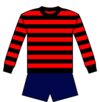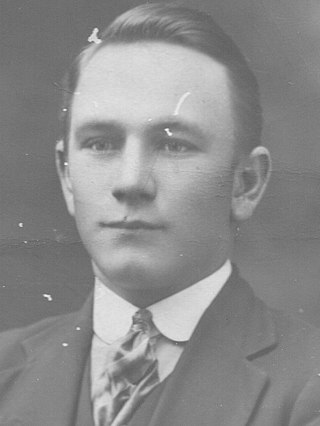The competition was decided on which side had the most premiership points at the end of the year. After the regular season had completed, the top four teams played an extra round in order break the deadlock between South Sydney and Eastern Suburbs which both ended up on 18 points. After these two teams won their respective semi-finals, a final was played. South Sydney overcame a depleted Eastern Suburbs side to take away the inaugural premiership.
Final
Both teams were weakened by the absence of players selected to travel to England on the first Kangaroo tour. [14]
The following is a report from The Sydney Morning Herald newspaper on the final between South Sydney and Eastern Suburbs.
"The final match to determine the premiership in the first grade of the Rugby League was played on the Agricultural Society's Ground on Saturday in perfect weather. The match was shorn of much interest on account of prominent members of both teams being absent, on their way to England. In accordance with the League rules, one-third of the profits of the match will be devoted to charity. The game, which was brilliant, and at times rather rough, resulted in a victory for South Sydney by 14 points to 12. The winners deserved their victory.
South Sydney lost the toss, and kicked off from the southern end, an easterly wind blowing across the ground, and the sun shining strongly against them. Play hummed from the beginning. South Sydney having the better of matters, the forwards putting in splendid work. Getting the ball from the scrum repeatedly, South Sydney's backs executed several brilliant bursts, but the tackling of their opponents was very safe. However, they broke through once, Conlin making a beautiful feinting run, and then passing to Senior, on the wing, the latter scoring a pretty try.
Immediately afterwards Herb Brackenrigg kicked a penalty goal for Eastern Suburbs. South Sydney now attacked strongly, and appeared likely to score, but Horrie Miller, intercepting a yard or so from his own line, raced the whole length of the ground and scored a beautiful try behind the posts. Brackenrigg converted, making the scores 7 points to 3 in favour of Eastern Suburbs.
On resuming South Sydney obtained the upper hand, forwards and backs playing brilliantly. They made repeated dashes, but could not break through for a long time. Once Storie got across, but was tackled. Then the three-quarters made fine dashes on either wing. From the last of these, which ended on the line, Golden scored a try, which Green failed to convert. Just before half time, Edward Fry marked at Eastern Suburb's 25, and Conlin kicked a fine goal, South Sydney leading by 8 points to 7.
The second half proved exciting from start to finish, Eastern Suburbs at first attacked and South Sydney got out of the difficulty by forcing. South Sydney now became aggressive, the three-quarters combining very neatly. They repeatedly penetrated the defence, but could not put the finishing touch to the movements for some time. At length Levison obtained a scrum and passed to Conlin, on the wing. The latter dashed for the line, and scored. The kick at goal failed. South Sydney 11 points to 7.
Eastern Suburbs put in fine work. Dan Frawley and Brackenrigg dribbling almost to the line. Then McNamara dropped a field goal from centre, which reduced South Sydney's lead to 2 points. McNamara almost repeated the performance a few minutes later, South Sydney rallied, and Levison getting from a scrum at the 25 passed in to Butler, who scored. The kick at goal failed.
Play now became very rough, several players being knocked out temporarily, and the referee had to administer cautions. Near time, Eastern Suburbs came with a rush, and Miller scored a good try, which Brackenrigg failed to convert.
There was no further scoring, South Sydney winning by 14 points to 12. [15]
| 14 | South Sydney |
|---|
| Tries | Senior, Golden, Conlin, Butler |
|---|
| Goals | Conlin 1/4 |
|---|
| Field Goals | |
|---|
| 12 | Eastern Suburbs |
|---|
| Tries | Miller 2 |
|---|
| Goals | Brackenreg 2/2 |
|---|
| Field Goals | McNamara |
|---|
|
















